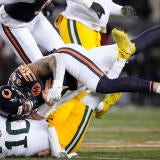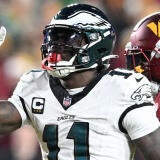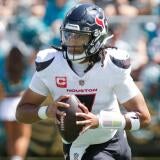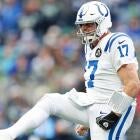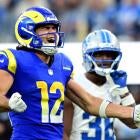NFL trends that will carry into 2023 season: Invest heavily in the offensive line, be aggressive, and more
Let's examine the biggest developments from this NFL season that teams will 'copy' in the future

Recency bias is a helluva drug. And the conference title games and Super Bowl always shape narratives for how to build a team, what style of offense and defense to incorporate, what the rest of the league should prioritize during the team-building process, etc. It happens every year. After the Eagles' first Super Bowl win their usage of the "Run-Pass Option" made RPO vernacular overnight. Mahomes' Super Bowl win the following year pushed the new mold for the prototypical franchise quarterback.
Last year, I highlighted the league's growing propensity to go for it on fourth down, pass on first down, and prioritize YAC. Those trends aren't going anywhere. To touch on them briefly here -- teams are still noticeably more aggressive on fourth down than they were even five to 10 years ago. That's good.
The Bengals and Chiefs finished third and fourth, respectively, in first-down pass rate during the regular season. Eight of the 14 playoff teams were in the top 10 in first-down pass rate and first-down pass rate in one-score game scenarios. If the NFL is a copycat league, other teams need to mimic what the best teams are doing, and one of those things is passing it more frequently than they run it on first down, even if the game is close.
And YAC is here to stay for a while. The Chiefs finished with the most total YAC during the regular season. The 49ers had the best YAC-per-reception average. The Chiefs were second in that category, while the Eagles were fifth and Bengals were 11th despite Ja'Marr Chase missing four contests.
Sometimes these trends are drawn directly from the regular season. But they're mostly drawn from the playoffs.
Let's identify those trends before Super Bowl LVII.
Invest heavily in the offensive line
The 49ers made the Super Bowl after the 2019 season, ultimately losing to Mahomes and the Chiefs. Less than two months later, they traded a fifth and future third for future first-ballott Hall of Fame left tackle Trent Williams. Big swing.
While they did allow burgeoning guard Laken Tomlinson to bolt in free agency after the 2021 season, they drafted Aaron Banks in the second round in 2021 and spent a fourth-round choice on guard Spencer Burford last April, two players who were the primary starters at guard in the 2022 season.
After Burrow led the NFL in sacks taken (51) in 20221, the Bengals spent a total of $22 million in collective average-pear-year salary on three blockers in the 2022 offseason -- La'el Collins, Ted Karras and Alex Cappa. They did so despite drafting four offensive linemen since Burrow went No. 1 overall in 2020, and they drafted another blocker in fourth-round pick Cordell Volson last April.
Unsurprisingly, Burrow's sacks (51 to 41) and sack rate (8.9% to 6.3%) decreased from 2021 to 2022. His interception rate also dipped from 2.7% to 2.0%.
After a cataclysmic development in the Super Bowl loss to the Buccaneers -- in a game without multiple starting offensive linemen -- Kansas City knows the pitfalls of that development now: the Chiefs did not sit on their hands. GM Brett Veach signed top free agent guard Joe Thuney to a five-year, $80 million deal with almost $32M in full guarantees, and traded multiple picks to land left tackle Orlando Brown from the AFC rival Ravens, but the blocking reconstruction wasn't finished.
In the draft, Veach picked longtime Oklahoma center Creed Humphrey in the second round and took a flier on guard Trey Smith in the sixth round, a big and talented SEC blocker who dealt with blood clots in college.
Now, Kansas City probably has the best blocking unit in the AFC.
The Eagles and GM Howie Roseman have long prioritized the trenches and have boasted one of the league's most devastating offensive lines for a while. It's mostly a veteran-laden group led by center Jason Kelce and right tackle Lane Johnson. But Roseman's persistence in building the blocking unit has once again paid major dividends.
After Jordan Mailata was a seventh-round flier in the 2018 draft, Roseman picked Andre Dillard in Round 1 in 2019. Dillard hasn't become the stud many thought he'd be in the NFL. Mailata has blossomed into a gargantuan road-grader. The ascending arrow up front didn't stop Roseman from selecting do-everything blocker Landon Dickerson in Round 2 of the 2021 draft -- who's now the starting left guard -- and even grabbing uber-talent center Cam Jurgens in the second round of the 2022 draft to be the eventual Kelce replacement.
The Eagles have the best offensive line in football and mostly manhandled the top-ranked 49ers defense in the NFC title game.
During the regular season, only 12 qualifying quarterbacks managed a passer rating over 75 while under pressure. When kept clean a whopping 39 passers had a quarterback rating over 75.
When in doubt, take fliers on quarterbacks
In the 2020 draft, at pick No. 53, after five quarterbacks had been selected, the Eagles selected Jalen Hurts after one highly productive season at Oklahoma that followed a unique career at Alabama. This choice was made less than four months after the Eagles won a divisional title and star quarterback Carson Wentz was knocked out of a playoff loss with a concussion. It was before that season that Wentz got a sizable, four-year, $128 million extension with the Eagles that included $100 million guaranteed.
Wentz threw for over 4,000 yards that season with 27 touchdowns to just seven interceptions.
The Eagles could've gone in plenty of other directions with that pick. But they understood the potential added value of selecting a quarterback there and did so. Wentz fell apart in 2020 and was subsequently traded. Hurts then was the quarterback on a seven-seed Philadelphia team that lost in the first round of the 2021 playoffs and now will be starting in the Super Bowl.
The 49ers got to a Super Bowl and NFC title game with Jimmy Garoppolo then decided to trade a litany of early picks to ascend the draft board to select Trey Lance. Of course last April they used the last pick in the draft on none other than Brock Purdy.
Be aggressive ... be, be aggressive
From the most ubiquitous cheer on the sidelines of high school games in America to application in the NFL. This is somewhat of a combination of the above two points, but ... be aggressive. And I'm not suggesting more blitzes. I'm talking aggression with building the roster. This really could be an extension of what the Rams did before their Super Bowl-winning season a year ago.
Think of the exemplification of this idea Roseman demonstrated last offseason. He traded a first-round pick for A.J. Brown during Day 1 of the draft. If that wasn't enough -- and normally would be viewed as enough -- he scooped up James Bradberry nine days after he was released by the Giants in May. Then, to really hammer home his aggressive style -- Roseman traded a fifth and sixth in the 2024 draft for pesky safety/slot corner Chauncey Gardner-Johnson and a 2025 seventh in August.
Let's not forget -- and you'll hear plenty of reminders over the next two weeks until the Super Bowl -- Chiefs GM Brett Veach TRADED TYREEK HILL in the offseason, an idea that previously seemed implausible, a complete non-starter.
It netted the Chiefs:
- Part of the compensation package to trade up to select CB Trent McDuffie
- WR Skyy Moore
- Avoidance of contract for Hill with $30M in average per year and $52.5M in full guarantees
- 2024 fourth-round pick
- 2024 sixth-round pick
Kansas City then had money to sign the likes of Justin Reid, JuJu Smith-Schuster, Marquez Valdes-Scantling and Carlos Dunlap in July. It'll also give the Chiefs flexibility to sign their own this offseason.


